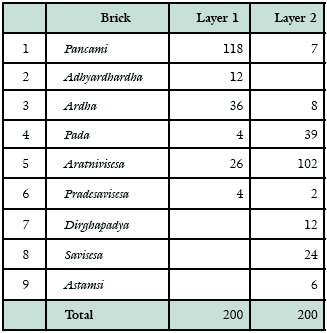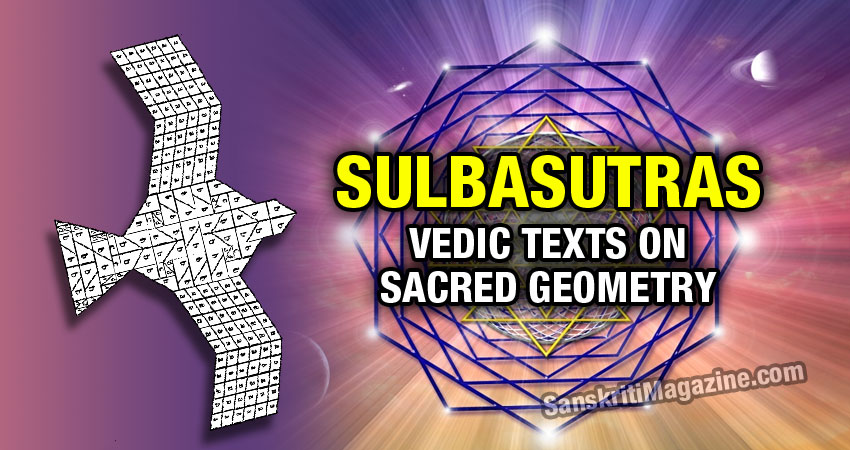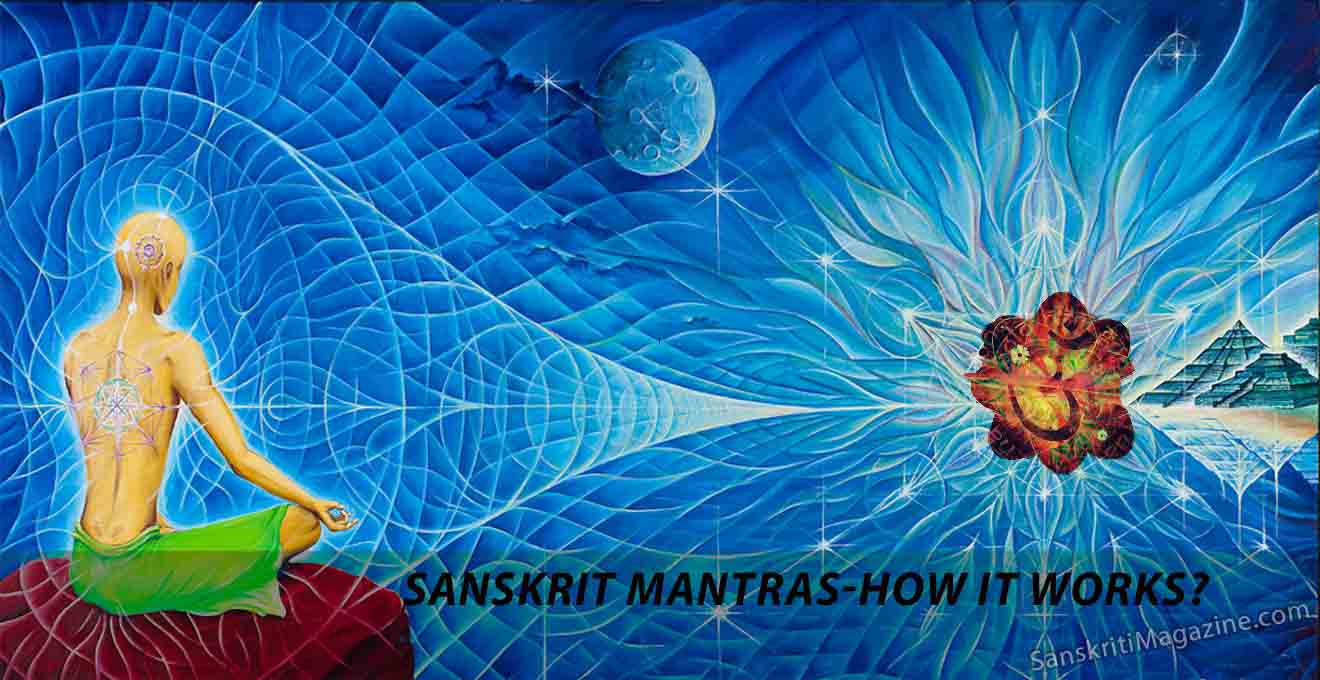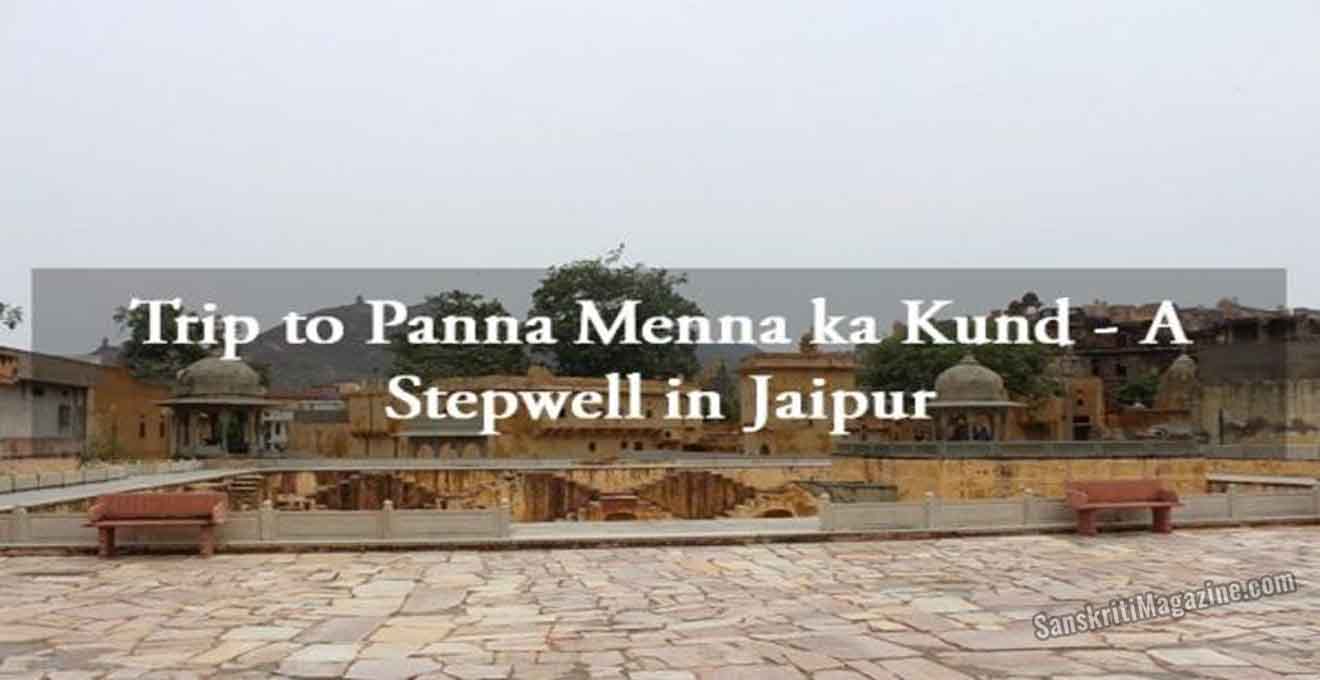The Sulbasutras deal with geometrical constructions, a large majority of them for the purpose of carrying out Vedic rituals at precisely constructed altars and similar such ends, that are popularly believed to date to the millennium before Christ or the end of the Vedic age. Of these, Baudhayana’s Sulbasutra is believed to date to the 8th century B.C. Later, other authors including Apastamba, Manava, Katyayana, Satyasadha Hiranyakesin, Vadhula, Varaha and Kathaka composed sulbasutras as well, although the chronological order in which these texts were composed remains unknown as yet.
The first five of the sulbasutras is found available in text form while the manuscripts of the others are known to exist. Still later, the commentaries of Kapardi, Karavinda, Sundararaja and Dwarkanath aappeared. In more recent times there have been commentaries written by Thibault and Van Geldner in the second half of the 19th century A.D., followed by S. N. Sen and the last by A.K. Bag in 1983.
Baudhayana’s work and his successors
The Baudhayana Sulbasutram (BSS) is possibly the most important sulbasutra text since it contains the principles of prescribed geometry for the Vedic altar space. Baudhayana, after dwelling upon the basic geometrical construction concepts prevalent during his and earlier times in the first set of sutra, described the Vedic altar space in general and then the 14 uttaravedi forms. His descriptions of the uttaravedis reveal a remarkable approach to geometry and the text serves as a model for technical accuracy and brevity. The order present in the geometrical analysis as well as in the flow of the text, its subject matter, reveal great clarity of thinking in the author’s mind and set the text apart from its later counterparts.
The later sulbasutras either dealt with matters mentioned in Baudhayana’s work and developed it further, or discussed issues that were omitted from this earlier work. Some of these works may be considered supplementary material. Katyayana’s text described how the construction of the uttaravedis may range from a size of 7.5to 101 purusam square in a clear narrative style. Similarly, Manava documented the examples of 8.5 square purusam uttaravedis, something that neither Baudhayana nor Katyayana had done. Manava further stated a new approach to the use of the purusam measure and a new unit of measure called pancangi. While a continuity of subject-matter may be observed in Katyayanaand Manava’s work, Apastamba’s output did not conform to the trend set by Baudhayana. No clear enhancement or elucidation of former works on geometry was discernible in his work. He described two forms of brick layout for the pithan syenaciti and new kanka and alaja citis, and his work on this proved to be very popular.
Recent Interest in the Sulbasutras
The cryptic style of the sulbasutra texts was essentially suited to the Vedic ritualists and in the wake of a break with traditional rituals and practices after the Vedic period, the texts could have lost their popular relevance. In some cases, this seems to be exactly what happened – a disconnect between the content of the text and the purposes to which it no longer was applicable. This made it very difficult to retrieve the sulbasutras completely at a later date when scholastic interest in them was reawakened. Therefore, it is doubtful how far the earlier mentioned commentaries are capable of revealing the real geometrical contents of the sulbasutra in all their glory.
The work done on the sulbasutras since the 19th century A.D. has, however, been followed with interest in recent times. It is clear that the major concern of the sulbasutra is geometry alone, although some observations of the srauta nature and certain mathematical operations connected with geometry also find mention in these texts. It is worth noting that the geometry of the sulbasutra has more affinity to modern engineering practice than to theoretical mathematics of the present times. This is natural given that the Vedic geometers were more concerned with accurate constructions of ritual altars and the altar space than with proving a theorem.
The essence of the sulbasutras lies more in the concepts discussed therein than in the authors’ use of grammatical accentuation. The latter was incidental Baudhayana employed the then prevalent style of the sutra and the other authors followed in a similar fashion. One of the reasons for the perhaps inaccurate reproduction of the geometry of the sulbasutra may be the approach adopted by later commentators, an approach that was affected by strongly pre-conceived grammatical notions. Instead, the sulbasutras ought to be approached with an inquiring mind regarding the meanings of the words in association exclusively with the subject under discussion. The modern Indian commentators further tend to find arithmetical and mathematical references in the sulbasutra, references that are unlikely to have been intended as such by the authors. One of the acid tests for the accuracy of presentation of a particular meaning is whether it may result in constructions of the Vedic style. Thus, while?2 is of great concern to the sulbavid (author of a sulbasutra) the same may not be said of?3 which is irrelevant to Vedic constructions, although more recent commentators have interpreted the sulbasutras to ascribe relevance to this numerical value.
The sulbasutra on the other hand reveal a great degree of development of geometry not only as applied to techniques of constructions, but also extending to conceptual symmetries and an unknown methodology of evolution of the conceptual approach to such geometry. While this is the very approach to basic geometry, it then becomes a passionate progress to various shapes of the uttaravedis. In fact, the very geometry of the mahavedi, in which the uttaravedi is an element, is of unique conceptual beauty. The 30-36-24 regular trapezium of the mahavedi contained several triples in their construction format such as 3-4-5, 12-5-13,15-9-17, 35-12-37 which could be employed to attain the accuracy of layout. The area of the mahavedi thus being 972 square of 18 prakramam, the uttaravedis were initially of 1/3rd of 972 and at the same time the square of 18. Then 1.3rd of 324 is 108, an important number since ancient times for obvious reasons. A trapezium shape of 10-12-8 amounting to an area of 108 thus became the smallest size of the uttaravedi in prakramam measures.
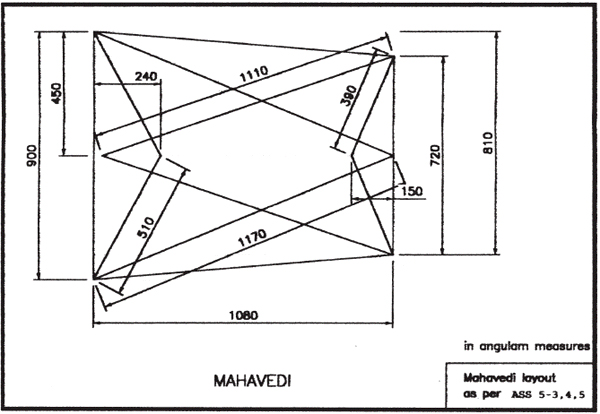 Figure 1: Mahavedi
Figure 1: MahavediThe taper of this trapezium narrowing down to the east is impressed upon by all the sulba texts. The eastward striving nature of the uttaravedi (for, gods reside at the east) is of paramount importance to the vedic rituals and one could not possibly say for what long period of time it took, to later develop into highly complex and realistic geometrical shapes in the form of three later uttaravedis, meant as kamyaciti. In the further development of the uttaravedis, the concept of “saptavidha: sampadyate”, meaning that the area of the uttaravedi should follow a certain pattern became a great spirit of enquiry. The eastward striving nature and this new concept put together developed into highly complex and yet beautifully conceived geometrical shapes of symmetry perhaps unparalleled in the history of geometry and mathematics. It is at an unknown point of time after that Baudhayana stood and decided to document it for posterity. And it is this very thing that the modern commentators, in a way, failed to redeem and realise.
At the very first, the term “saptavidha:” was insufficiently interpreted to mean as 7.5 times the purusam measure, whereas it was really referred to as the 7 stages of development from the 7.5 to the 101 as area and corresponding sizes. Later, Katyayana described this in good detail, which also went properly not delineated. While Manava updated to the mathematical order of his time and described several types of equalities and arithmetical series, it was ironically Apastamba who was accredited with several modern mathematical interpretations. As a whole, it would be fair to state that the magnificent total geometry of the sulbasutra remains undiscovered as on date. The BSS contains 21 major sutra sets, of which the first two describe basic geometrical constructs. They contain basic units of measurements, conversions from one shape to another of equal area, notions of right angles and the value of ?2 etc. Sutra 3 and 4 describe the geometry and general concepts of the total altar space. Sutra 5 and 6 are general in nature as well, but in sutra 7 an initiation of the geometrical complexities to follow is indicated by the description of the new garhapatyaciti of 21 bricks.
The general layout of the pracinasala and mahavedi, with a detailed definition of the position of the uttaravedi, is already clear at this point, since it uses the rathacakraciti with its well-defined centre for the purpose. The next 14 sutras are devoted to the various formats of the uttaravedi.
After describing 2 brick-laying orders of the pithan syenaciti, syenaciti of pancapatri, sadpatri, kanka and alaja forms are described. These distinct bird shaped altars used different methods to fulfill the “saptavidha:” concept with the 7.5 purusam square as the basis. All of them are based on clear symmetries and on basic formative squares and rectangles. Next, two simple triangular praugaciti are described. Then the geometrical content is intensified to describe the rathacakraciti, 3 dronociti, the smasanaciti, and the kurmaciti. Esoteric compositions are displayed in the final sutra which goes beyond the bounds set by basic, definitive principles. It is possible that this process of creative design and constructions was already declining before the time of Baudhayana and this motivated him to create the BSS text.
While going through the BSS text, one may doubt that all of the citi formats described by him were in practice during his time since the descriptions contain varying levels of details, though each of the descriptions could be termed as sufficient in itself. It is here and in the unknown nature of the time line that the strength of the sruti is revealed in its capacity to travel intact wide expanses of time. Indeed there are very specific examples of such demonstration of strength of the system in its further travel to our present times. What is more demonstrative in the second period of about 2800 years since Baudhayana is that the text travelled intact almost without its meanings really taken in. And yet there are words in the BSS which could have easily got transformed into something else but did not. Then there are such instances where certain versions of the manuscripts tried to inject words into the body text which were found to be stoically resisted by the extant contents.
In comparison, the later sulbasutra texts are explanatory in nature with some additional altar designs and some mathematical updates by the authors. These have definitely added strength to the information system on the one hand and then silently declared that they have stepped out of the sruti circuit to certain extent. The very sruti system might indeed have had several parallel flows where the sulbasutra and that of the rituallistic practices could have existed even without mixing. Where some amount of cross references only existed without one being part and parcel of the other is a distinct possibility. And possibilities for further studies are plentiful, as the present attempt of delineation of the sulbasutra could open up a better historical perspective and the timeline of the progress of not only geometry and mathematics of the period of first millenium BC but a host of other related subjects. It provides a better clarity to matters beyond the second millennium BC as well. For the geometrician of today and such enthusiasts, a large volume of exercise is provided by Katyayana, as his formulae for taking the citi forms from 7.5 to 101 purusam squares remain untested and untried.
A Few Sutras: An extract from the book
with Commentary by Parameswaran Murthiyedath
Sutra 12 (Kankaciti)
Sutra 12.1
Kankacita etenatma
Puccam ca vyakhyatam
(The Kankacita defined here will have a body and a tail)
The Kankacita is known to have the shape of a heron.
Sutra 12.2
sirasi pancopadadhyat
tasyakrtirvyakhyata
sirasi pancopadadhya
ttasyakrtirvyakhyata
(the head will be obtained as 5 by definition of its shape)
As per the definition the head will be obtained as 5.
This states that the length of the head along the east west is 5 aratni from the body. With the same words a meaning that the area of the head is 5 sq. aratni could also be derived. Both meanings are true and so meant.
Sutra 12.3
Saptapancasaddaksine paksa upadadhyat
tathottare
Saptapancasaddaksinepaksa upadadhya
ttathottare
(5 and 7 to south the wing will be obtained next the north)
The wing at south will be obtained as 5 and 7and likewise the north. Again, The wing tips are at a distance of 12aratni’s to south (5+7) and at the same time it means that the area of the wings are 57 sq. aratni.
Sutra 12.4
Vyayamena sapradesna paksayorapanamah
pancamabhagiyardhyabhih sat sat patrani kuryat
adhyardhavasisyate vyayamena
sapradesnapaksayorapanamah
pancamabhagiyardhyabhih
sat sat
patrani kuryat
adhyardhavasisyate
(by vyayama measure with the pradesa the wings bent with the pancami and adhyardha six and six wing cuts as stated an adhyardha will be balanced)
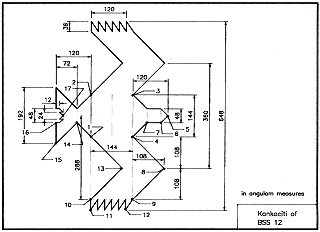 Figure 2: Karika city layout (BSS-12.2-6)
Figure 2: Karika city layout (BSS-12.2-6)(The wings will be set out at a measure of 1 vyayama added with 1 pradesa at an angle and the wings tips will have six notches of a measurement of 1 pancami by 1 pancami and a half. An adhyardha will be balanced)
The configuration of the wings are made by the diagonal of a square of 108A first taken forward and then retraced to give a mirrored bent. The sutra further categorically states that the wing tips configuration is with 6 nos of 1aratni by 1 adhyardha cuts. This adds to the area of 54 sq. aratni and additional 3aratni and the statement of 57 sq. aratni are now established. The statement ‘adhyardhavasisyate’ is about the excess area resulted amounting to 1½ aratni in the configuration which will be later adjusted by the leg trimming of the tail.
Fig. 12.1 given here shows the citi geometry. First a basic square 1-2-3-4 will be established with side as 144A, deriving from the statement of ‘saratnipradesa’. The south end of the wings from which the wing tips take off is line 9-10, parallel to1-4 and at a distance of 12 aratni (288A). Line 4-8 is the diagonal of a square of 108A as side. Line 8-9 is mirrored from line 4-8. Thus the wing formation of 4-8-9-10-13-1 is established. The six wing tips are formed by the diagonals of boxes of an aratni by an adhyardha (1½ aratni) as sides, as shown within9-10-11-12.
Sutra 12.5
taya pucchasyavastat
padavaratnimatravaratnyantaralau
pradesavyasau bhavatah
tayoravastadabhito
dvaudvavastamabhagau pragbhedavupadadhyat
taya pucchasyavastat
padavaratnimatravaratnyantaralau
pradesavyasau bhavatah
tayoravastadabhito
dvaudvavastamabhagau
pragbhedavupadadhyat
(At the backside of the tail feet of an aratni length in an aratni gap with 1 pradesa as width at the back and near as 2 and 2, and 8 sided with a forward cut will be obtained)
The tail is having a forward cut of 1 aratni length and 1 pradesa as width of sides, in a gap of 1 aratni, and thus having 8 sides split into two as forward cut.
The tail portion of 15-14-16-17 contains the details mentioned above. Thus the tail have two cuts of 1 aratni square which is modified to form the root and two such feet are placed touching each other as stated forming an 8 sided cut in total.
A statement like ‘pancadasa pucche’ is judiciously left out for the reason of the cut in the tail, though the overall outline agreed to such a statement. Further in sutra 12.8 the placement of two astamsi bricks at the tail to obtain this configuration are mentioned, to which the presentation here corresponds.
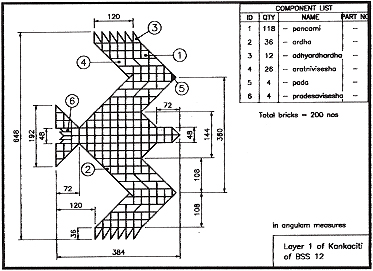 Figure 2: Karika city layer 1
Figure 2: Karika city layer 1Sutra 12.6
evam saratnipradesah saptavidhah sampadyate
evam saratnipradesah
saptavidhah sampadyate
(With only the aratni and pradesa the saptavidhah concept will be achieved)
Thus with the aratni and pradesa measures alone, the saptavidhah concept will be achieved. Indeed, the altar shape graphically feeds back an area report of exactly 7.5 times the purusam square, as could also be seen from the calculation of area given here.
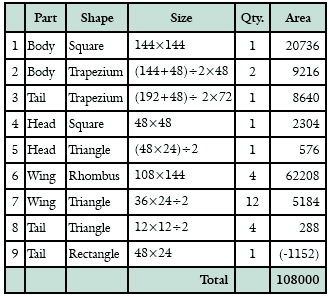 Table 1: Area of Kankacit
Table 1: Area of KankacitSutra 12.7
athestakanam vikarah
pancamabhagiyah
savayavah
padestakam caturbhih
parigrhniyadardhapradesenadhyardhapradesena
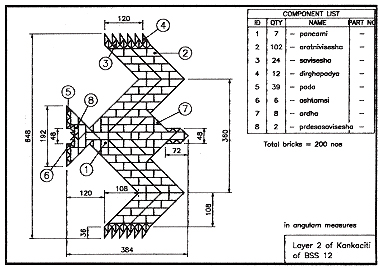 Figure 4: Karika city, Layer 2
Figure 4: Karika city, Layer 2pradesena pradesasavises eneti
adhyardhestakam caturbhih parigrhniyadardhavyayamena
dvabhyamaratnibhyamaratnisavises eneti
tah sat
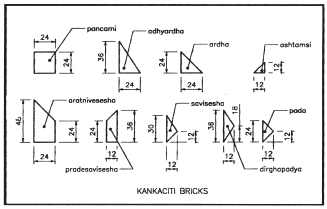 Figure 5: Karika city, Bricks
Figure 5: Karika city, BricksAthestakanam
Vikarah
pancamabhagiyah savayavah
padestakam caturbhih
parigrhniyadardhapradesenadhyardhapradesena
pradesena pradesasavises eneti
adhyardhestakam
caturbhih
parigrhniyadardhavyayamena
dvabhyamaratnibhyamaratnisavises eneti
tah sat
Now the bricks configuration with the pancami all over with the pada square brick with surrounded (sliced) ardha and pradesa and the adhyardha and pradesa and the adhyardha and pradesa with pradesa and a modified pradesa with the adhyardha brick from a square brick with the surrounded (sliced) half vyayama by two and by aratni and aratni modified like that six.
With pancami as the basic brick allover with the pada of a square brick, and the ardha, the adhyardhardha and pradesa sliced, the vyayama and the aratni sliced, the modified aratni consisting 6 bricks will be used.
However, some more bricks are found required and the lists of bricks are as given below:
Sutra 12.8
tasam
caturasrapadyah
sastamabhagah
padayorupadhaya
sesam yathayogam
yathasamkhyam yathaadharmam
copadadhyat
with these the caturasrapadyah and 8 divided part at the wings having placed balance as required in as many numbers as per rules be placed
The caturasrapadyah and the astamsi bricks having placed as the feet, the balance will be filled with the required numbers as per rules.
